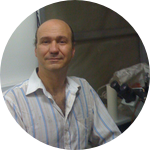About This Project
Ion channels mediate all forms of biological electrical activity. I developed a new analysis method called covariance fitting(CVF). Unlike conventional methods, CVF does not involve surrogate parameters, but creates a direct link between recorded ion channel data and the properties of the actual channels. It is a form of maximum likelihood fitting, the most powerful method of extracting information from data. Support will allow me to apply this method to data that has already been collected.
Ask the Scientists
Join The DiscussionWhat is the context of this research?
Understanding any biological entity involves 2 questions. What it is and what it does, the structure-function relationship. Structurally, a protein is a linear sequence of amino acids that folds into a 3D object. The function of a complex protein comes from its ability to adopt different conformational states, much the same way a dancer might adopt different foot or arm positions.
Ion channel research typically involves recording the flow of ions through small patches of membrane, generating surrogate parameters and using those parameters to make guesses about the conformational states. Covariance fitting (CVF), the method to be used here, allows a direct connection between the data and the conformational states of the channel.
What is the significance of this project?
A thermodynamic model is a description of the energy levels of different the conformational states a protein can adopt. It is a bridge between structure and function. Just as the choreography determines what positions a dancer will might adopt during a dance, the respective energy levels determine what conformational states a protein will adopt in response to a changing environment. CVF provides a direct link between experimental data and the energy states of an ion channel. This will opening the door to descriptions of ion channel function never seen before. It will be possible to describe in a more precise way how function is affected both by extrinsic chemical agents such as drugs, as well as intrinsic changes in the amino acid composition.
What are the goals of the project?
My current focus is on an ion channel found primarily in the CNS (ASIC1a) that responds to changes in pH. It is implicated in a wide variety of physiological and pathological processes. Calcium has a dramatic effect on ASIC1a function. My collaborators have recorded data on ASIC1a function at a physiological calcium concentration as well as at both high and low calcium. I am close to publishing a thermodynamic model of ASIC1a at physiological calcium. The next step will be to apply CVF to the data recorded at high and low calcium. This will allow a precise description of how calcium affects ASIC1a function in terms of changes in the energy levels of the different states. It will also serve to demonstrate the power of the CVF method.
Budget
In order to maintain my academic position, I am required to be on salary. The funds requested here will satisfy that for at least 6 months. The data I am analyzing has already been collected. The computers I will need have already been purchased.
Endorsed by
Meet the Team
James J. Celentano
I started as an MD-PhD candidate at SUNY Downstate in 1981, graduated with an MD in 1989, did an internship from 1989-1990 and completed my PhD in 1991. My thesis work was on modulation of the GABA receptor. I remain fascinated by the process by which small compounds like drugs affect larger entities like ion channels. How does something the size of a marble affect something the size of a basketball? It has become clear to me that the only way to understand this process is on a thermodynamic level.
I completed a residency in emergency medicine in 1997 and returned to Downstate to take a voluntary position as a Research Assistant Professor. Since then I have been practicing Emergency medicine on a part-time basis allowing me to devote more time to research. I was awarded an RO3 from NIH in 2000 to study modulator interaction at the GABA receptor. The first thing I set out to do was test the conventional method of data analysis (still widely used). I found it to be hopelessly flawed. None of the experts in the ion channel field could explain the problem until I met Dr. Alan Hawkes who knew exactly what was wrong and gave me the formula that forms the basis of CVF. Since then my only goal has been to validate the method and apply it to as many ion channels as possible.
By 2006 I had published the paper describing the CVF method, but was unable to get funding despite 7 NIH applications, 3 NSF applications and various appeals to private sources. Nearly bankrupt, I began a collaboration with a lab in Shanghai which is still ongoing. They are interested in acid sensing ion channels and a post-doc collected the data sets described above. Unfortunately ASIC1a is much more complicated than expected. The paper I am preparing describes a model with 32 distinct states. Throughout this process I have remained committed to doing this and doing it right.
Additional Information
The original description of the CVF method is described in Celentano and Hawkes, Biophysical Journal 2004 v87 pp276-294. The method has advanced greatly since then, unfortunately it has thus far been impossible to obtain support. The choice of ASIC1a as a model system also turned out to be unfortunate as it is a very complex channel. That said, once the first paper is published, I am confident it will definitively demonstrate the power of this method.
Thanks to Ruthie Stephens for narrating the video.
Project Backers
- 10Backers
- 178%Funded
- $5,351Total Donations
- $535.10Average Donation

